平狄克《微观经济学》(第7版)笔记(第18章 外部性与公共品)
外部性与公共品

7、公共物品与外部性的关系
区别
公共物品强调的是成本与收益的非排他性和非竞争性,是物品本身的属 性,本质在于如何使公共物品的供应更加合理、更有效率;外部效应强 调的是个体经济行为给其他行为主体带来的收益与成本问题,是某一经 济行为的存在性影响问题,其本质在于怎样更合理地分担成本与收益, 以达到资源的最优配置。
所有制论:外部效应的存在源于产权的不明晰。 如前面提到的“公用地的悲剧”问题。
6、外部性的纠治:私人解决办法
其一,财产权的分配——产权界定 科斯第一定理认为,在产权明确的前提下,如果交易成本为零或小得可 以忽略不计,市场机制自身可以通过协商谈判的方式使外部效应内部化, 达到资源的最优配置。 科斯第二定理认为,在产权明确的前提下,如果交易成本不为零或不是 小得可以忽略不计,那么合理的制度安排可以减少交易成本,使内部效 应内部化,合理地配置资源。 举例:如何内部化——种植小麦 的农民和养牛的牧民
其四,法律系统 限制:诉讼的交易成本较大而损失较小、厂商对外部性的损失进行控制、 诉讼结果的不确定性。
7、公共物品与外部性的关系
联系
公共物品的非排他性即不付费就可以分享物品的益处是典型的私人边际收益大于 社会边际收益、私人边际成本小于社会边际成本情况;公共物品的非竞争性意味 着增加一个人消费不会引起生产成本的增加,其生产成本是既定的,所以某一公 共物品的提供对所有的消费者都产生了外部效应。 因此,在一定的意义上,外部效应可与消费的非竞争性和非排他性共同定义纯公 共物品与纯私人物品:外部性与消费的非竞争性和非排他性强的物品更具有纯公 共物品的特性,外部性与消费的非竞争性和非排他性弱的物品更具有纯私人物品 的特性。 也是在这个意义上,任何物品的生产与提供都会产生一定的外部效应,只不过有 的物品的外部效应不那么明显,而公共物品则是带来外部效应的极端的情况。
(完整word版)平狄克《微观经济学》第八版笔记
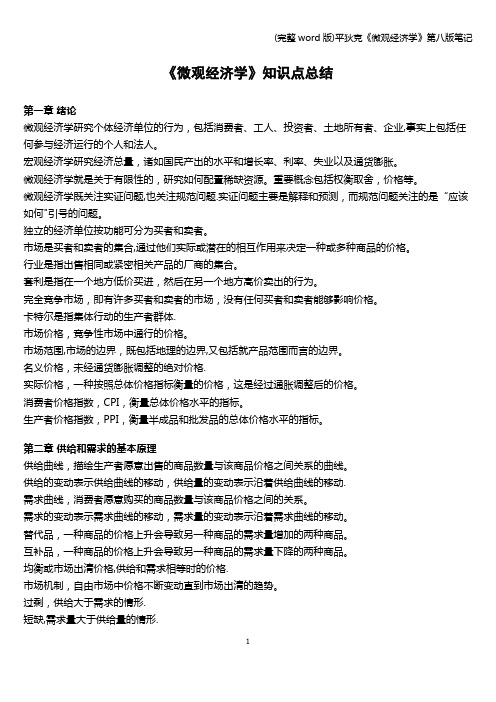
《微观经济学》知识点总结第一章绪论微观经济学研究个体经济单位的行为,包括消费者、工人、投资者、土地所有者、企业,事实上包括任何参与经济运行的个人和法人。
宏观经济学研究经济总量,诸如国民产出的水平和增长率、利率、失业以及通货膨胀。
微观经济学就是关于有限性的,研究如何配置稀缺资源。
重要概念包括权衡取舍,价格等。
微观经济学既关注实证问题,也关注规范问题.实证问题主要是解释和预测,而规范问题关注的是“应该如何"引号的问题。
独立的经济单位按功能可分为买者和卖者。
市场是买者和卖者的集合,通过他们实际或潜在的相互作用来决定一种或多种商品的价格。
行业是指出售相同或紧密相关产品的厂商的集合。
套利是指在一个地方低价买进,然后在另一个地方高价卖出的行为。
完全竞争市场,即有许多买者和卖者的市场,没有任何买者和卖者能够影响价格。
卡特尔是指集体行动的生产者群体.市场价格,竞争性市场中通行的价格。
市场范围,市场的边界,既包括地理的边界,又包括就产品范围而言的边界。
名义价格,未经通货膨胀调整的绝对价格.实际价格,一种按照总体价格指标衡量的价格,这是经过通胀调整后的价格。
消费者价格指数,CPI,衡量总体价格水平的指标。
生产者价格指数,PPI,衡量半成品和批发品的总体价格水平的指标。
第二章供给和需求的基本原理供给曲线,描绘生产者愿意出售的商品数量与该商品价格之间关系的曲线。
供给的变动表示供给曲线的移动,供给量的变动表示沿着供给曲线的移动.需求曲线,消费者愿意购买的商品数量与该商品价格之间的关系。
需求的变动表示需求曲线的移动,需求量的变动表示沿着需求曲线的移动。
替代品,一种商品的价格上升会导致另一种商品的需求量增加的两种商品。
互补品,一种商品的价格上升会导致另一种商品的需求量下降的两种商品。
均衡或市场出清价格,供给和需求相等时的价格.市场机制,自由市场中价格不断变动直到市场出清的趋势。
过剩,供给大于需求的情形.短缺,需求量大于供给量的情形.弹性,某一变量变动1%所引起的另一变量变动的百分比。
微观经济学课件第18章外部性

18.3 纠正外部性的措施
(1)用科斯定理纠正负外部性 以“一条河,上游有家造纸厂,下游有个养 鱼场”为例,造纸厂根据自己的边际成本与边 际收益的比较将产量确定在Q1(见图18.3)。 根据前述分析,此时由于存在着负外部性, 使得造纸厂生产得过多,污染得过于严重,显 然这会给下游养鱼场带来很大损失,设该损失 大小为A元。如果让造纸厂减少排污,即减少造 纸产量致Q*,那么肯定会给造纸厂带来损失, 设该损失大小为B元。由于此时的状态不是帕累
18.3 纠正外部性的措施
18.3.2 通过市场自行解决
所谓“帕累托改进”是指这样一种改变, 它能使起码一个社会成员的福利水平因此而得 到改善,同时又不会使任何一个社会成员的利 益因此而受损。 而所谓“帕累托最优”就是指不存在帕累托 改进余地的资源分配状态。
18.3 纠正外部性的措施
18.3.2 通过市场自行解决
18.3 纠正外部性的措施
18.3.1 通过政府进行干预
(2)政府弥补“正外部性”的手段——补贴和优 惠券 对造成正外部性的企业,国家则可以采取 补贴(Subsidy)的办法,使得企业的边际私人 收益与边际社会收益相等。
补贴
P
MC B C A MB 0 Q1 Q*
S
MSB
Q
图18.2:具有正外部性的生产活动
18.3 纠正外部性的措施
① 庇古税(Pigou Tax) 用于纠正外部效应影响的税收被称为庇古 税。这是为了纪念最早提出这种方法的英国经 济学家阿瑟. 庇古(A. C. Pigou)。 制定这种税收的具体内容是:对造成负外 部性的企业,国家应该征税,其数额应该等于 该企业给社会其他成员造成的损失,也就是边 际外部影响,从而使该企业的私人成本等于社 会成本。
平狄克《微观经济学》第9版笔记和课后习题详解(外部性与公共物品)【圣才出品】

平狄克《微观经济学》第9版笔记和课后习题详解第18章外部性与公共物品18.1复习笔记【知识框架】【考点难点归纳】考点一:外部性★★★外部性是指一个经济主体的经济活动对他人和社会造成的非市场化影响,这种影响既可以是正向也可以是负向。
当某个经济主体的行为使他人或社会受益,而受益者无须付出任何代价时,称之为正的外部性;当某个经济主体的行为使他人或社会受损,而行为主体却无须为此承担成本时,称之为负的外部性。
由于外部性并不反应在市场价格中,因此可能会导致经济无效率和市场失灵。
1.负的外部性和无效率当存在负的外部性时,边际社会成本(MSC)大于边际私人成本(MC),差额就是边际外部成本(MEC)。
从社会的角度看,由于厂商未能将与负外部性伴随的成本纳入考虑,导致生产过剩。
有效产出水平应当是价格等于生产的边际社会成本。
外部性既导致短期也导致长期的无效率。
厂商通过对比产品价格和生产的平均成本来决定是否进入行业:价格高于成本,厂商就进入;价格低于成本,厂商就退出。
在长期均衡中,价格等于(长期)平均成本。
当存在负的外部性时,平均私人生产成本低于平均社会成本,厂商判断产品价格高于其生产的成本即平均私人成本,选择留在产业内,但对社会而言是无效率的。
2.正的外部性和无效率当存在正的外部性时,边际社会收益(MSB)大于边际私人收益(D),差额就是边际外部收益(MEB),即MSB=D+MEB。
有效产出水平处于MSB和MC曲线的相交处。
正的外部性也会导致无效率。
一个正的外部性导致无效率的例子就是厂商在研究与开发上所花费的钱,研究带来的创新常常难以受到保护而被别的厂商得到,研发投资得不到回报就无法再获得资金支持。
考点二:纠正市场失灵的办法★★★污染是外部性导致市场失灵的一般例子,可以通过排污标准、排污费、可转让排污许可证或者通过鼓励再生利用得到纠正。
在成本和收益都存在不确定性时,这些机制的选择,取决于边际社会成本和边际收益曲线的形状。
平狄克《微观经济学》【教材精讲】第18章 外部性和公共品 【圣才出品】

第18章外部性和公共品18.1本章框架结构图18.2重难点解读一、外部性1.外部性的含义一般来说,当一个消费者的福利或者一家企业的生产可能性直接受到经济中的另一个当事人的行为影响时,就说该经济中存在着外部性(externality)。
外部性的影响会造成私人成本和社会成本之间,或私人收益和社会收益之间的不一致,因此容易造成市场失灵。
对于外部性,要理解以下几点:(1)“直接受到”。
即个人A的福利“直接受到”个人B的行为的影响。
这种影响是直接的,不是通过市场价格机制的中介而施加的。
(2)外部性存在于消费领域,也存在于生产领域。
(3)外部性可分为正的外部性和负的外部性。
2.外部性的分类外部性的影响方向和作用结果具有两面性,可以分为外部经济和外部不经济。
那些能为社会和其他个人带来收益或能使社会和个人降低成本支出的外部影响被称为外部经济,它是对个人或社会有利的外部性;那些能够引起社会和其他个人成本增加或导致收益减少的外部影响被称为外部不经济,它是对个人或社会不利的。
具体来说,外部影响可分为:生产的外部经济、消费的外部经济、生产的外部不经济和消费的外部不经济。
3.负的外部性和无效率由于存在负外部性,边际私人成本MC 会小于边际社会成本MSC ,差额就是边际外部成本MEC 。
从社会角度来看,具有负外部性的厂商生产的产出太多了。
有效产出水平应当是价格等于生产的边际社会成本一一边际生产成本加上边际外部成本。
负外部性使一些低效率的厂商继续保留在行业内,从而导致长期内的过量生产。
图18-1外部成本如图18-1所示,当存在负的外部性时,边际社会成本MSC 大于边际私人成本MC ,差额就是边际外部成本MEC 。
在(a)图中,利润最大化的产量为1q ,价格等于MC 。
有效产出是q *。
在(b)图中,产业的竞争性产出是1Q ,有效产出Q *要比它低,由需求和边际社会成本1MSC 的交点决定。
4.正的外部性和无效率当有正外部性时,一项经济活动所带来的私人边际成本与社会边际成本相等,但边际社会收益MSB大于边际私人收益D,差额就是边际外部收益MEB。
中财-微观平迪克版-18章_外在性和公共产品

16 of 36
18.2 纠正市场失灵的办法
押金
图 18.10 押金
Chapter 18 Externalities and Public Goods
刚开始玻璃容器市场的供给为 Sv ,再生利用玻璃的供给是Sr 。
市场总供给S是两条曲线的水 平加总。
结果,玻璃的市场价格P和再 生利用玻璃的均衡供给是M1。
2 of 36
18.1
外在性
● 外在性 无论是生产者还是消费者的行动影响其他生 产者或消费者,但不计入市场价格。
Chapter 18 Externalities and Public Goods
负的外部性和无效率
● 边际外在成本 当一个或更多的公司增加一个单位的产 出时,外部施加的成本增加。
● 边际社会成本. 产出的边际成本和边际外在成本之和。
Chapter 18 Externalities and Public Goods
随着废料处理的数量的增 加,边际私人成本MC增 加,但是低于边际社会成 本MSC。
再生利用的边际成本曲线 MCR表明随着废料的减少, 再生利用的数量增加;再 生利用的边际陈本增加。
Copyright © 2009 Pearson Education, Inc. Publishing as Prentice Hall • Microeconomics • Pindyck/Rubinfeld, 7e.
Copyright © 2009 Pearson Education, Inc. Publishing as Prentice Hall • Microeconomics • Pindyck/Rubinfeld, 7e.
3 of 36
18.1
平狄克微观经济学答案——第18章 外部性和公共产品
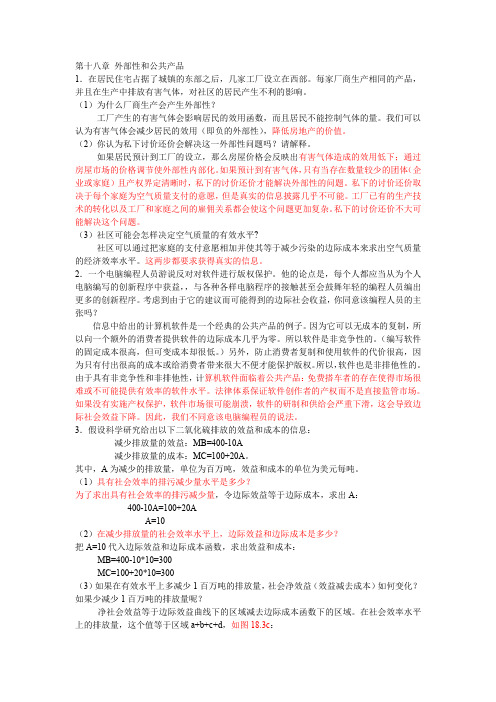
第十八章外部性和公共产品1.在居民住宅占据了城镇的东部之后,几家工厂设立在西部。
每家厂商生产相同的产品,并且在生产中排放有害气体,对社区的居民产生不利的影响。
(1)为什么厂商生产会产生外部性?工厂产生的有害气体会影响居民的效用函数,而且居民不能控制气体的量。
我们可以认为有害气体会减少居民的效用(即负的外部性),降低房地产的价值。
(2)你认为私下讨价还价会解决这一外部性问题吗?请解释。
如果居民预计到工厂的设立,那么房屋价格会反映出有害气体造成的效用低下;通过房屋市场的价格调节使外部性内部化。
如果预计到有害气体,只有当存在数量较少的团体(企业或家庭)且产权界定清晰时,私下的讨价还价才能解决外部性的问题。
私下的讨价还价取决于每个家庭为空气质量支付的意愿,但是真实的信息披露几乎不可能。
工厂已有的生产技术的转化以及工厂和家庭之间的雇佣关系都会使这个问题更加复杂。
私下的讨价还价不大可能解决这个问题。
(3)社区可能会怎样决定空气质量的有效水平?社区可以通过把家庭的支付意愿相加并使其等于减少污染的边际成本来求出空气质量的经济效率水平。
这两步都要求获得真实的信息。
2.一个电脑编程人员游说反对对软件进行版权保护。
他的论点是,每个人都应当从为个人电脑编写的创新程序中获益,,与各种各样电脑程序的接触甚至会鼓舞年轻的编程人员编出更多的创新程序。
考虑到由于它的建议而可能得到的边际社会收益,你同意该编程人员的主张吗?信息中给出的计算机软件是一个经典的公共产品的例子。
因为它可以无成本的复制,所以向一个额外的消费者提供软件的边际成本几乎为零。
所以软件是非竞争性的。
(编写软件的固定成本很高,但可变成本却很低。
)另外,防止消费者复制和使用软件的代价很高,因为只有付出很高的成本或给消费者带来很大不便才能保护版权。
所以,软件也是非排他性的。
由于具有非竞争性和非排他性,计算机软件面临着公共产品:免费搭车者的存在使得市场很难或不可能提供有效率的软件水平。
平狄克《微观经济学》(第7版)习题详解(第18章 外部性与公共品)

平狄克《微观经济学》(第7版)第18章外部性与公共品课后复习题详解跨考网独家整理最全经济学考研真题,经济学考研课后习题解析资料库,您可以在这里查阅历年经济学考研真题,经济学考研课后习题,经济学考研参考书等内容,更有跨考考研历年辅导的经济学学哥学姐的经济学考研经验,从前辈中获得的经验对初学者来说是宝贵的财富,这或许能帮你少走弯路,躲开一些陷阱。
以下内容为跨考网独家整理,如您还需更多考研资料,可选择经济学一对一在线咨询进行咨询。
1.下列哪个描述了外部性,哪个没有?解释它们的区别。
(1)巴西限制咖啡出口的政策导致美国咖啡的价格上升,它反过来又导致茶叶的价格上升。
(2)一则广告传单使一个驾驶汽车的人分心,结果使他撞上一根电线杆。
答:(1)巴西限制咖啡出口的政策没有外部性。
巴西限制咖啡出口的政策导致美国咖啡的价格上升,是因为美国所面临的咖啡的供给减少了。
因为咖啡的价格提高,所以消费者转向咖啡的替代品茶,从而使得茶的需求增加,因此导致茶叶价格的上升。
这是市场的作用,而不是外部性。
(2)广告传单有外部性。
广告传单通过宣传某些产品或服务而传达信息。
但是,它传达这些信息的方式可能会使驾驶汽车的人分心,对那些在电线杆附近的驾驶者就可能会造成事故。
因为广告公司索取的广告费中并不包含使驾驶者分心的外部性的成本,传单对驾驶者产生了危害他们安全的负的外部性。
两者的区别在于:巴西的这项政策对美国产生的影响并没有造成其私人成本和社会成本之间,或其私人收益和社会收益之间的不一致,所以没有外部性;而广告传单对它所处的经济环境产生负面影响,所以具有外部性。
2.在减污的成本和收益不确定时,比较和对照下列三种对付污染外部性的机制:(a)排污费;(b)排污标准;(c)可转让排污许可证制度。
答:(1)三种机制的含义排污费是对厂商每单位污染物的收费。
征收一定的排污费将产生有效率的行为。
排污标准是对厂商可以排放多少污染物的法定限制。
如果厂商超过限制,它就会面临经济惩罚甚至刑事惩罚。
平狄克《微观经济学》(第8版)配套题库(下册)-章节题库-外部性和公共物品【圣才出品】
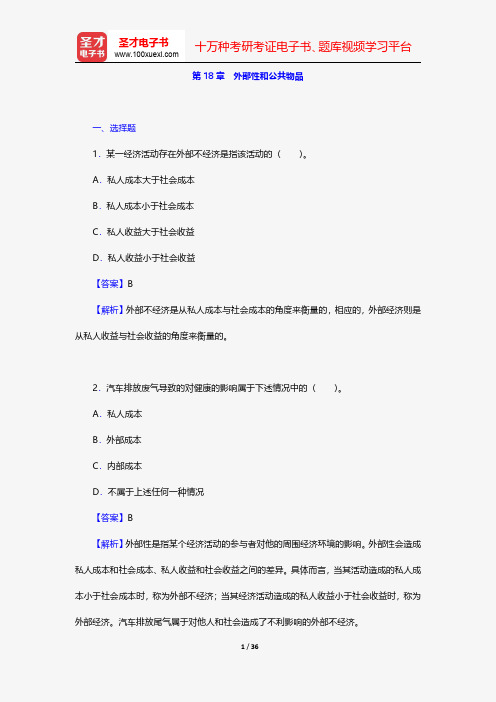
第18章外部性和公共物品一、选择题1.某一经济活动存在外部不经济是指该活动的()。
A.私人成本大于社会成本B.私人成本小于社会成本C.私人收益大于社会收益D.私人收益小于社会收益【答案】B【解析】外部不经济是从私人成本与社会成本的角度来衡量的,相应的,外部经济则是从私人收益与社会收益的角度来衡量的。
2.汽车排放废气导致的对健康的影响属于下述情况中的()。
A.私人成本B.外部成本C.内部成本D.不属于上述任何一种情况【答案】B【解析】外部性是指某个经济活动的参与者对他的周围经济环境的影响。
外部性会造成私人成本和社会成本、私人收益和社会收益之间的差异。
具体而言,当其活动造成的私人成本小于社会成本时,称为外部不经济;当其经济活动造成的私人收益小于社会收益时,称为外部经济。
汽车排放尾气属于对他人和社会造成了不利影响的外部不经济。
3.从社会角度来看,效率要求()之间相等。
A.社会边际收益和社会边际成本B.社会边际收益和私人边际收益C.社会边际成本和私人边际收益D.社会边际成本和私人边际成本【答案】A【解析】当社会边际收益和社会边际成本相等时,社会实现了帕累托最优状态。
4.如果一种产品的社会边际收益大于私人边际收益,()。
A.价格低于有效率的价格B.社会应减少产品的生产C.私人有效率的结果也是社会有效率的D.社会应增加产品的生产【答案】D【解析】当社会边际收益大于私人边际收益时,存在外部经济,私人活动的水平常常低于社会所要求的最优水平。
为达到帕累托最优状态,社会应当增加产品生产。
5.被称作外部经济效果的市场失灵发生在()。
A.当市场价格不能反映一项交易的所有成本和收益时B.当竞争建立在自身利益最大化的前提上时C.当厂商追求利润最大化目标时D.当市场不能完全出清时【答案】A【解析】外部性是指某个经济活动的参与者对他的周围经济环境的影响,外部性出现的主要原因是私人成本与社会成本、私人收益与社会收益的不一致。
因此当市场价格不能反映一项交易的所有成本和收益时,容易出现外部性。
《外部性和公共物品》PPT课件
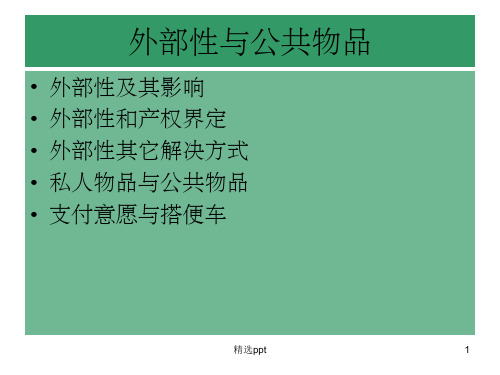
• 排他性(Excludability)指人们必须支付价格才能 消费商品,存在把没支付价格者排除在消费以外 的现实手段。
精选ppt
17
非竞争性
• 有的产品消费具有非竞争性(Non-rivalry), 更多人消费无需增加边际成本(或边际成 本很小可忽略不计),因而,某人消费某 种商品并不妨碍其他人同时消费这一产品。 例如,公路在没有达到交通拥挤之前,增 加一辆汽车的边际成本几乎为零,并且也 不会妨碍其他人驾驶。船只航行利用的灯 塔设施具有非竞争性。放飞在天空的观赏 性汽球,电视节目,互联网等等,其消费 过程都具有非竞争性特点。
• 运用类似的分析,可以发现存在正外部性时,市场竞争机
制结果导致生产和消费不足,同样发生市场缺乏效率的市
场失灵问题。
精选ppt
5
外部性与市场有效性(2)
• 右图表示负外部性导致过 度供给和消费。D表示对 价格 纸张的需求曲线,MCp表 示厂家私人生产边际成本。 假设市场是完全竞争的, 则边际成本曲线就是厂商 的供给曲线。因而在市场 机制作用下依据私人成本, MCp确定的最优产量是Qp; 然而,依据社会边际成本 MCs决定的最优产量应当 是Qs。由于私人成本MCp 线在社会成本MCs以下, 所以市场最优产量Qp 高 0 于社会最优产量Qs。导致 生产和消费过多的缺乏效 精选ppt 率问题。
• ——科斯定理有两点理解。
精选ppt
10
分析视角转换
• 第一,对于污染造成的外部性,产权分析不再看 作是一方损害和一方受损害的问题,而是两种各 自具有合理性权利行使过程中发生的矛盾。
• 上面事例中,化肥厂有权利用自己所有的生产设 备等要素,产出销售化肥获得利益;另一方面, 农民同样有权利利用自己的土地等要素,产出和 销售水果谋求利益。然而,双方行使所有权过程 发生了利益冲突:一方面化肥厂要求排放废气, 即要求“污染”权利,另一方面农民要求不被废 气污染:市场主体行使所有权产生了新的权利问 题即产权界定问题。
平狄克《微观经济学》(第7版)课后习题详解 第18章 外部性与公共品【圣才出品】

第18章外部性与公共品18.1课后复习题详解1.下列哪个描述了外部性,哪个没有?解释它们的区别。
(1)巴西限制咖啡出口的政策导致美国咖啡的价格上升,它反过来又导致茶叶的价格上升。
(2)一则广告传单使一个驾驶汽车的人分心,结果使他撞上一根电线杆。
答:(1)巴西限制咖啡出口的政策没有外部性。
巴西限制咖啡出口的政策导致美国咖啡的价格上升,是因为美国所面临的咖啡的供给减少了。
因为咖啡的价格提高,所以消费者转向咖啡的替代品茶,从而使得茶的需求增加,因此导致茶叶价格的上升。
这是市场的作用,而不是外部性。
(2)广告传单有外部性。
广告传单通过宣传某些产品或服务而传达信息。
但是,它传达这些信息的方式可能会使驾驶汽车的人分心,对那些在电线杆附近的驾驶者就可能会造成事故。
因为广告公司索取的广告费中并不包含使驾驶者分心的外部性的成本,传单对驾驶者产生了危害他们安全的负的外部性。
两者的区别在于:巴西的这项政策对美国产生的影响并没有造成其私人成本和社会成本之间,或其私人收益和社会收益之间的不一致,所以没有外部性;而广告传单对它所处的经济环境产生负面影响,所以具有外部性。
2.在减污的成本和收益不确定时,比较和对照下列三种对付污染外部性的机制:(a)排污费;(b)排污标准;(c)可转让排污许可证制度。
答:(1)三种机制的含义排污费是对厂商每单位污染物的收费。
征收一定的排污费将产生有效率的行为。
排污标准是对厂商可以排放多少污染物的法定限制。
如果厂商超过限制,它就会面临经济惩罚甚至刑事惩罚。
可转让排污许可证是一种可以产生数量一定且有限的污染的许可证,它分配在各个厂商之间并且可以在它们之间进行买卖。
(2)排污费和排污标准的比较①某一点的有效排放水平可以通过排污费或者排污标准来实现。
如图18-1所示,*E点的有效排污水平可以通过排污费或者排污标准来实现。
当面临每单位排放3美元的费时,厂商减少排放直至排污费等于边际收益那一点。
同样水平的排放削减可以用标准将排放限制在12单位来实现。
平狄克《微观经济学》(第8版)章节题库(外部性和公共物品)【圣才出品】
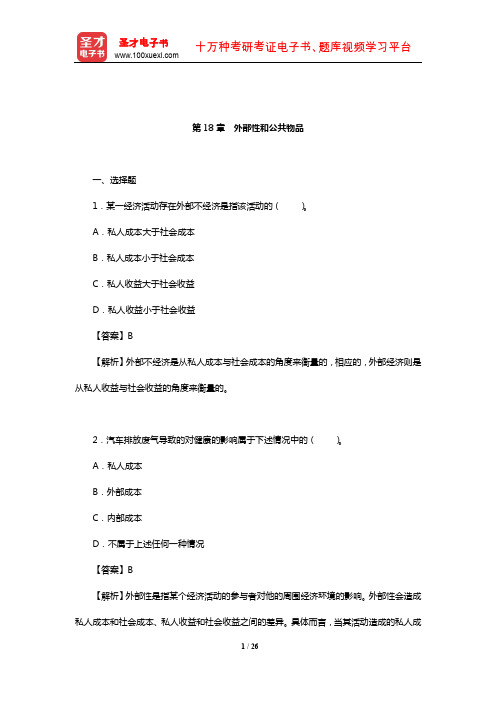
第18章外部性和公共物品一、选择题1.某一经济活动存在外部不经济是指该活动的()。
A.私人成本大于社会成本B.私人成本小于社会成本C.私人收益大于社会收益D.私人收益小于社会收益【答案】B【解析】外部不经济是从私人成本与社会成本的角度来衡量的,相应的,外部经济则是从私人收益与社会收益的角度来衡量的。
2.汽车排放废气导致的对健康的影响属于下述情况中的()。
A.私人成本B.外部成本C.内部成本D.不属于上述任何一种情况【答案】B【解析】外部性是指某个经济活动的参与者对他的周围经济环境的影响。
外部性会造成私人成本和社会成本、私人收益和社会收益之间的差异。
具体而言,当其活动造成的私人成本小于社会成本时,称为外部不经济;当其经济活动造成的私人收益小于社会收益时,称为外部经济。
汽车排放尾气属于对他人和社会造成了不利影响的外部不经济。
3.从社会角度来看,效率要求()之间相等。
A.社会边际收益和社会边际成本B.社会边际收益和私人边际收益C.社会边际成本和私人边际收益D.社会边际成本和私人边际成本【答案】A【解析】当社会边际收益和社会边际成本相等时,社会实现了帕累托最优状态。
4.如果一种产品的社会边际收益大于私人边际收益,()。
A.价格低于有效率的价格B.社会应减少产品的生产C.私人有效率的结果也是社会有效率的D.社会应增加产品的生产【答案】D【解析】当社会边际收益大于私人边际收益时,存在外部经济,私人活动的水平常常低于社会所要求的最优水平。
为达到帕累托最优状态,社会应当增加产品生产。
5.被称作外部经济效果的市场失灵发生在()。
A.当市场价格不能反映一项交易的所有成本和收益时B.当竞争建立在自身利益最大化的前提上时C.当厂商追求利润最大化目标时D.当市场不能完全出清时【答案】A【解析】外部性是指某个经济活动的参与者对他的周围经济环境的影响,外部性出现的主要原因是私人成本与社会成本、私人收益与社会收益的不一致。
因此当市场价格不能反映一项交易的所有成本和收益时,容易出现外部性。
平狄克《微观经济学》(第7版)笔记(第18章-外部性与公共品)
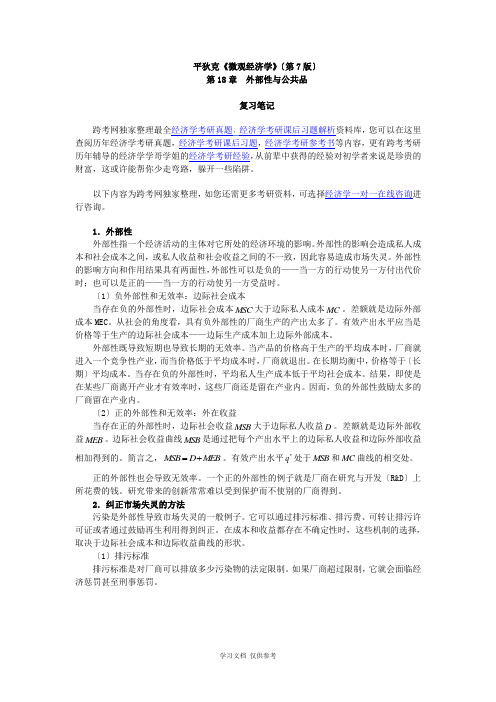
平狄克《微观经济学》〔第7版〕第18章外部性与公共品复习笔记跨考网独家整理最全经济学考研真题,经济学考研课后习题解析资料库,您可以在这里查阅历年经济学考研真题,经济学考研课后习题,经济学考研参考书等内容,更有跨考考研历年辅导的经济学学哥学姐的经济学考研经验,从前辈中获得的经验对初学者来说是珍贵的财富,这或许能帮你少走弯路,躲开一些陷阱。
以下内容为跨考网独家整理,如您还需更多考研资料,可选择经济学一对一在线咨询进行咨询。
1.外部性外部性指一个经济活动的主体对它所处的经济环境的影响。
外部性的影响会造成私人成本和社会成本之间,或私人收益和社会收益之间的不一致,因此容易造成市场失灵。
外部性的影响方向和作用结果具有两面性,外部性可以是负的——当一方的行动使另一方付出代价时;也可以是正的——当一方的行动使另一方受益时。
〔1〕负外部性和无效率:边际社会成本当存在负的外部性时,边际社会成本MSC大于边际私人成本MC。
差额就是边际外部成本MEC。
从社会的角度看,具有负外部性的厂商生产的产出太多了。
有效产出水平应当是价格等于生产的边际社会成本——边际生产成本加上边际外部成本。
外部性既导致短期也导致长期的无效率。
当产品的价格高于生产的平均成本时,厂商就进入一个竞争性产业,而当价格低于平均成本时,厂商就退出。
在长期均衡中,价格等于〔长期〕平均成本。
当存在负的外部性时,平均私人生产成本低于平均社会成本。
结果,即使是在某些厂商离开产业才有效率时,这些厂商还是留在产业内。
因而,负的外部性鼓励太多的厂商留在产业内。
〔2〕正的外部性和无效率:外在收益当存在正的外部性时,边际社会收益MSB大于边际私人收益D。
差额就是边际外部收益MEB。
边际社会收益曲线MSB是通过把每个产出水平上的边际私人收益和边际外部收益相加得到的。
简言之,M SB D M EB=+。
有效产出水平*q处于MSB和MC曲线的相交处。
正的外部性也会导致无效率。
一个正的外部性的例子就是厂商在研究与开发〔R&D〕上所花费的钱。
平狄克微观经济学知识点
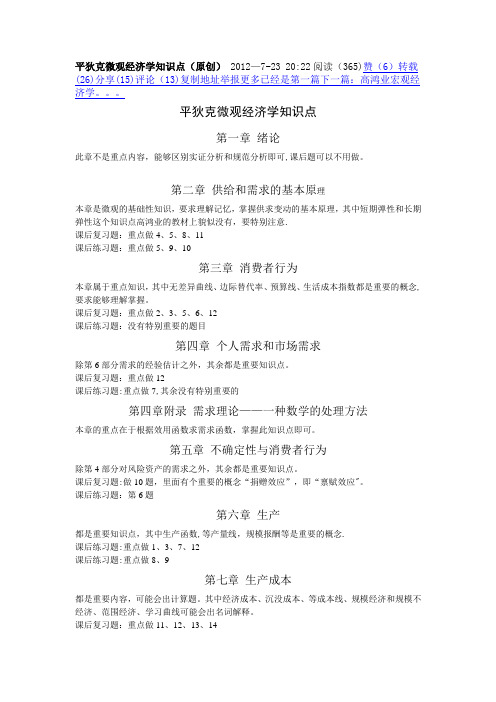
平狄克微观经济学知识点(原创)2012—7-23 20:22阅读(365)赞(6)转载(26)分享(15)评论(13)复制地址举报更多已经是第一篇下一篇:高鸿业宏观经济学。
平狄克微观经济学知识点第一章绪论此章不是重点内容,能够区别实证分析和规范分析即可,课后题可以不用做。
第二章供给和需求的基本原理本章是微观的基础性知识,要求理解记忆,掌握供求变动的基本原理,其中短期弹性和长期弹性这个知识点高鸿业的教材上貌似没有,要特别注意.课后复习题:重点做4、5、8、11课后练习题:重点做5、9、10第三章消费者行为本章属于重点知识,其中无差异曲线、边际替代率、预算线、生活成本指数都是重要的概念,要求能够理解掌握。
课后复习题:重点做2、3、5、6、12课后练习题:没有特别重要的题目第四章个人需求和市场需求除第6部分需求的经验估计之外,其余都是重要知识点。
课后复习题:重点做12课后练习题:重点做7,其余没有特别重要的第四章附录需求理论——一种数学的处理方法本章的重点在于根据效用函数求需求函数,掌握此知识点即可。
第五章不确定性与消费者行为除第4部分对风险资产的需求之外,其余都是重要知识点。
课后复习题:做10题,里面有个重要的概念“捐赠效应”,即“禀赋效应"。
课后练习题:第6题第六章生产都是重要知识点,其中生产函数,等产量线,规模报酬等是重要的概念.课后练习题:重点做1、3、7、12课后练习题:重点做8、9第七章生产成本都是重要内容,可能会出计算题。
其中经济成本、沉没成本、等成本线、规模经济和规模不经济、范围经济、学习曲线可能会出名词解释。
课后复习题:重点做11、12、13、14课后练习题:重点做8、9、11、12、13第七章附录生产和成本理论——一个数学的处理课后题1、2、3可以做做,不难。
第八章利润的最大化和竞争性供给是重点章节,完全竞争市场可能会出计算,生产者剩余、行业的长期供给曲线可能会出名词解释.课后复习题:1、2、3、4、5、10课后练习题:4、5、10、11第九章竞争性市场分析本章是核心知识点,几种模型的福利变化分析,包括图形、原理等必须理解、熟记.很可能会出大题或者是计算题,要能够计算福利变化。
平狄克《微观经济学》(第7版)【教材精讲+考研真题解析】讲义与视频课程【32小时高清视频】
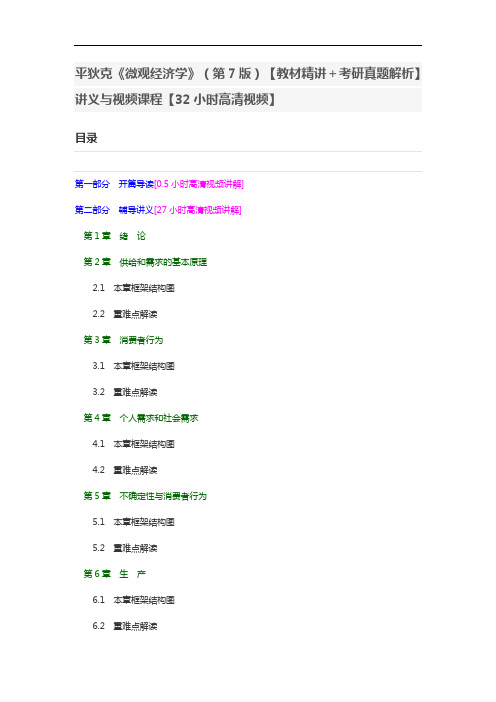
平狄克《微观经济学》(第7版)【教材精讲+考研真题解析】讲义与视频课程【32小时高清视频】目录第一部分开篇导读[0.5小时高清视频讲解]第二部分辅导讲义[27小时高清视频讲解]第1章绪论第2章供给和需求的基本原理2.1 本章框架结构图2.2 重难点解读第3章消费者行为3.1 本章框架结构图3.2 重难点解读第4章个人需求和社会需求4.1 本章框架结构图4.2 重难点解读第5章不确定性与消费者行为5.1 本章框架结构图5.2 重难点解读第6章生产6.1 本章框架结构图6.2 重难点解读第7章成产成本7.1 本章框架结构图7.2 重难点解读第8章利润最大化和竞争性供给8.1 本章框架结构图8.2 重难点解读第9章竞争性市场分析9.1 本章框架结构图9.2 重难点解读第10章市场势力:垄断与买方垄断10.1 本章框架结构图10.2 重难点解读第11章有市场势力的定价11.1 本章框架结构图11.2 重难点解读第12章垄断竞争和寡头竞争12.1 本章框架结构图12.2 重难点解读第13章博弈论和竞争策略13.1 本章框架结构图13.2 重难点解读第14章投入要素市场14.1 本章框架结构图14.2 重难点解读第15章投资、时间及资本市场15.1 本章框架结构图15.2 重难点解读第16章一般均衡与经济效率16.1 本章框架结构图16.2 重难点解读第17章信息不对称市场17.1 本章框架结构图17.2 重难点解读第18章外部性和公共品18.1 本章框架结构图18.2 重难点解读第三部分名校考研真题名师精讲及点评[4.5小时高清视频讲解]一、名词解释二、简答题三、计算题四、论述题内容简介本书特别适用于参加研究生入学考试指定考研参考书目为平狄克《微观经济学》的考生,也可供各大院校学习平狄克《微观经济学》的师生参考。
平狄克所著的《微观经济学》(中国人民大学出版社)被列为“十一五”国家重点图书出版规划项目,是我国众多高校采用的经济学优秀教材,也被众多高校(包括科研机构)指定为“经济类”专业考研参考书目。
平狄克微观经济学答案英语版Ch18

CHAPTER 18EXTERNALITIES AND PUBLIC GOODSTEACHING NOTESThis chapter discusses the remaining types of market failure that were introduced at the end of Chapter 16 and were not covered in Chapter 17. Section 18.1 defines the concept of externalities, both positive and negative. Section 18.2 discusses methods of correcting for the market failure that arises in the presence of externalities. These two sections give a good self-contained overview of externalities and possible remedies. If you have limited time, at least try to cover these sections.Section 18.3 considers stock externalities where the social cost is due to the accumulated stock of a pollutant. Global warming is an example that will garner student interest. If you want to pursue the global warming example (Example 18.5), you might consider assigning Exercise 8, but do so only if students know how to calculate net present values. If you do assign Exercise 8, you probably ought to give students the exact net benefit values for all 101 years. These are provided with the answer for that exercise in the following pages. Without the exact values, you will not be able to solve for the requested discount rate.Section 18.4 deals with property rights and the Coase theorem. Section 18.5 discusses common property resources such as fisheries, and Section 18.6 covers public goods. Section 18.7 offers a brief discussion of determining the optimal level of a public good. Overall the chapter provides a good overview of some very interesting problems. Any instructor who has the time and desire to expand upon the presentation in the chapter can find a wealth of information by consulting an environmental or resource economics textbook. There are an abundance of examples related to pollution and natural resource issues that you could talk about. Check your local newspaper for ideas.The production and consumption of many goods involve the creation of externalities. Stress the divergence between social and private costs, and the difference between the private (competitive) equilibrium and the socially optimal (efficient) equilibrium. Although private competitive markets produce too much pollution, it is critical to make sure students understand that the optimal amount of pollution is not zero. In fact, it is interesting to ask students to define what zero pollution would mean (it’s not entirely clear) and what life would be like without pollution (no cars, trucks, man-made fertilizer, computers, cell phones, etc., etc.).You can use students’ knowledge of consumer and producer surplus to explore the welfare gain of moving from the competitive to the efficient equilibrium. Exercise 9 presents the classic beekeeper/apple-orchard problem, originally popularized in James E. Meade, “External Economies and Diseconomies in a Competitive Situation,” Economic Journal, March 1952, 62:245, 54-67. Empirical research on this example has shown that beekeepers and orchard owners have solved many of their problems: see Steven N.S. Cheung, “The Fable of the Bees: An Economic Investigation,” Journal of Law and Economics, April 1973, 16:1, 11-33.One of the main themes of the law and economics literature since 1969 is the application of Coase’s insight on the assignment of property rights. The original article is clear and can be understood by students. Stress the problems posed by transactions costs. For a lively debate, ask students whether non-smokers should be granted the right to smokeless air in public places (see Exercise 5). For an extended discussion of the Coase Theorem at the undergraduate level, see A. Mitchell Polinsky, Chapters 3-6, An Introduction to Law & Economics, Aspen Publishers, 3rd edition, 2003.The last two sections of the chapter focus on public goods and private choice. Point out the similarities and differences between public goods and other activities with externalities. Since students confuse nonrival and nonexclusive goods, create a table similar to the following and give examples to fill in the cells:Nonexclusive ExclusiveRival Most Goods Congested Local RoadsNonrival Cable TV Programs Public GoodsWhen determining the amount of a public good the government should provide, some students will not understand why we add individual demand curves vertically rather than horizontally. Stress that by summing horizontally we are finding the total quantity supplied/demanded at any given price. By summing vertically we are finding the total willingness to pay for a given quantity. The coverage of public choice is a limited introduction to the subject, but you can easily expand on this material. A logical extension of this chapter is an introduction to cost-benefit analysis. For applications of this analysis, see Part III, “Empirical Analysis of Policies and Programs,” in Robert H. Haveman and Julius Margolis (eds.), Public Expenditure and Policy Analysis, Houghton Mifflin, 3rd edition, 1983.QUESTIONS FOR REVIEW1. Which of the following describes an externality and which does not? Explain the difference.a. A policy of restricted coffee exports in Brazil causes the U.S. price of coffee to rise –an increase which in turn also causes the price of tea to rise.Externalities cause inefficiencies because the price of the good does not reflect the truesocial value of the good. A policy of restricting coffee exports in Brazil causes the U.S.price of coffee to rise because supply is reduced. As the price of coffee rises, consumersswitch to tea, thereby increasing the demand for tea, and hence increasing the price oftea. These are market effects, not externalities.b.An advertising blimp distracts a motorist who then hits a telephone pole.The advertising blimp is producing information. However, its method of supplying thisinformation can be distracting for some consumers, such as those who happen to bedriving. The blimp is creating a negative externality that influences drivers’ safety.Since the price the advertising firm charges its client does not incorporate theexternality of distracting drivers, too much of this type of advertising is produced fromthe point of view of society as a whole.2. Compare and contrast the following three mechanisms for treating pollution externalities when the costs and benefits of abatement are uncertain: (a) an emissions fee, (b) an emissions standard, and (c) a system of transferable emissions permits.The choice between an emissions fee and an emissions standard depends on themarginal cost and marginal benefit of reducing pollution. First, suppose small changesin abatement yield large benefits while adding little to cost. In this case, if anemissions fee is set too low because of uncertainty, the firm will produce far too manyemissions, so a standard is better. However, if small changes in abatement yield littlebenefit while adding greatly to cost, the cost of reducing emissions is high. In this case,fees should be used because setting a standard too high (due to uncertainty) yields littlebenefit but increases costs way beyond the efficient level.A system of transferable emissions permits combines the features of fees and standardsto reduce pollution. Under this system, a standard is set and fees are used to transferpermits to firms that value them the most (i.e., firms with high abatement costs).However, because of uncertainty, the total number of permits can be incorrectly chosen.Too few permits will reduce emissions to inefficiently low levels and create excessdemand for the permits, increasing their price and inefficiently diverting resources toowners of the permits.Typically, pollution control agencies implement one of the three mechanisms, measurethe results, reassess the success of their choice, then reset new levels of fees orstandards or select a new policy tool.3. When do externalities require government intervention? When is such intervention unlikely to be necessary?Economic efficiency can be achieved without government intervention when theexternality affects a small number of people so that bargaining costs are small. As theCoase theorem tells us, the resulting outcome will be efficient in this case regardless ofhow property rights are specified. When these conditions are not met, governmentintervention is often required.4. Consider a market in which a firm has monopoly power. Suppose in addition that the firm produces under the presence of either a positive or a negative externality. Does the externality necessarily lead to a greater misallocation of resources?In the presence of a negative externality, a competitive market produces too muchoutput compared to the socially optimal amount. But a monopolist restricts output,so it is possible that the monopolist will produce an output closer to the sociallyoptimal solution. In the case of a positive externality, competitive firms produce toolittle output. Because a monopolist produces even less output, the monopolist causesa greater misallocation of resources.5. Externalities arise solely because individuals are unaware of the consequences of their actions. Do you agree or disagree? Explain.Disagree. It is not that people are unaware but that they have no economic incentiveto consider and account for all of the consequences of their actions. If a firm dumpswaste into a river that affects a swimming area downstream, it is generating anegative externality for the people downstream. This action maximizes the firm’sprofit if the firm incurs no private costs for dumping and is not forced to consider theexternal costs it is imposing on users of the swimming area. This is true whether thefirm is aware of these social costs or not.6. To encourage an industry to produce at the socially optimal level, the government should impose a unit tax on output equal to the marginal cost of production. True or false? Explain.This statement is false. While a tax can encourage firms to produce at the sociallyoptimal level, the tax should be set equal to the marginal external cost and not themarginal private cost. Competitive firms will maximize profit by producing at thepoint where price is equal to marginal cost. When there are external costs involvedthe marginal private cost of the firm is too low from society’s point of view, and as aresult too much output is produced. By setting a tax equal to the additional cost notbeing realized by the firm (the marginal external cost) the firm will be encouraged toconsider all costs and will reduce output because the tax will increase its overallmarginal cost.7. George and Stan live next door to each other. George likes to plant flowers in his garden, but every time he does, Stan’s dog comes over and digs them up. Stan’s dog is causing the damage, so if economic efficiency is to be achieved, it is necessary that Stan pay to put up a fence around his yard to confine the dog. Do you agree or disagree? Explain.Disagree. Economic efficiency does not require that Stan pay for the fence; it merelyrequires that Stan and George resolve the problem so that social welfare (totalbenefits less total costs) is maximized, regardless of who pays for it. For example,George and Stan could split the cost of a fence, George could pay Stan to get rid of hisdog, or Stan could pay George not to plant flowers.Given typical property rights, it seems likely that George could sue Stan and that acourt would require Stan to pay for a fence or get rid of his dog. And it seems fairthat Stan should have to do this, but it is not required for economic efficiency.8. An emissions fee is paid to the government, whereas an injurer who is sued and held liable pays damages directly to the party harmed by an externality. What differences in the behavior of victims might you expect to arise under these two arrangements?When victims can receive the damages directly, they are more likely to file a claim,initiate a suit, and try to overstate their damages. When victims do not receive thedamages directly, they are less likely to report violations and are less likely tooverstate their damages. In theory, emissions fees paid to the government equal thedamage inflicted on others and hence move firms toward the socially optimal level ofproduction. But since the fees are paid to the government rather than to theindividuals who were injured, the affected individuals are less likely to file a complaintthan they would if they received compensation for the damages directly.9. Why does free access to a common property resource generate an inefficient outcome?Free access to a resource means that the marginal cost to the user is less than themarginal social cost, because each user has no incentive to consider how his use of theresource will affect the use of the resource by others. The use of a common propertyresource by a person or firm reduces others’ use of it. For example, the use of water byone consumer restricts its use by another. Since private marginal cost is below socialmarginal cost, too much of the resource is consumed by the individual user, creating aninefficient outcome. Each individual using the common property resource considersonly his own actions and does not consider how all of the users collectively are affectingthe resource.10. Public goods are both nonrival and nonexclusive. Explain each of these terms and show clearly how they differ from each other.A good is nonrival if, for any level of production, the marginal cost of providing the goodto an additional individual is zero (although the cost to produce an additional unitcould be greater than zero). A good is nonexclusive if it is impossible or very expensiveto exclude individuals from consuming it once it is available to one individual. Publicgoods are nonrival and nonexclusive. Good examples are national defense, a lighthouseand public television. Some goods are nonrival but exclusive such as a bridge duringlow traffic periods. One more person can use the bridge without any additional cost tothe bridge authority and without imposing costs on other drivers in the form ofcongestion, but the bridge authority can exclude users by setting up tollbooths. Somegoods are nonexclusive but rival. For example, a large lake can be nonexclusive becauseanyone can use it, but the more people there are fishing, the fewer fish are available toothers, so it is rival.11. A village is located next to 1000 acres of prime grazing land. The village presently owns the land and allows all residents to graze cows freely. Some members of the village council have suggested that the land is being overgrazed. Is this likely to be true? These same members have also suggested that the village should either require grazers to purchase an annual permit or sell off the land to the grazers. Would either of these be a good idea?It is true that the common land is likely to be overgrazed since each individual willconsider only their own private cost and not the total social cost of grazing. Thesocial cost of grazing is likely to be higher than any one individual’s private costbecause no one individual has an incentive to take into account how his grazingaffects the opportunities of others. As a result, conservation efforts by individualsare pointless.For example, one individual could decide to graze only in certain areas during certaintimes of the year, while preserving other areas for other times of the year. However,the individual will not do this if the resource is common property as any other grazercan come along and freely disrupt the preservation system that the individual hasset up.Selling annual permits may help, but an annual permit will exclude only thosegrazers whose total benefits are less than the price of the permit. Anyone who buysthe permit will still have the same incentive to overgraze the commons. Selling theland outright is a better solution to the overgrazing problem. If an individualpurchases the land she will then have an incentive to consider all of the costsassociated with using the land, and as a result will use it in such a way that theresource is preserved, since she alone captures all of the benefits of preserving theresource. Another possibility would be to charge users based on the amount ofgrazing their cows do. If the grazing fee were set correctly, the efficient amount ofgrazing could be induced. However, it might be difficult to determine the correct fee,and the village would have to keep track of each resident’s grazing and bill him orher accordingly.12. Public television is funded in part by private donations, even though anyone with a television set can watch for free. Can you explain this phenomenon in light of the free rider problem?The free rider problem refers to the difficulty of excluding people from consuming anonexclusive commodity. Non-paying consumers can “free-ride” on commoditiesprovided by paying customers. Public television is funded in part by contributions.Some viewers contribute, but most watch without paying, hoping that someone elsewill pay so they will not have to. To combat this problem these stations ask consumersto assess their true willingness to pay and ask them to contribute up to this amount.They then attempt to make those people feel good about their actions and makeeveryone else feel guilty for free riding.13. Explain why the median voter outcome need not be efficient when majority-rule voting determines the level of public spending.The median voter is the citizen with the middle preference: half the voting populationis more strongly in favor of the issue and half is more strongly opposed. Undermajority-rule voting, where each citizen’s vote is weighted equally, the preferredspending level on public-goods provision of the median voter will win an electionagainst any other alternative. However, majority rule is not necessarily efficient,because it gives each citizen’s preferences equal weight. For an efficient outcome, wewould need a system that measures and aggregates the willingness to pay of thosecitizens consuming the public good. Majority rule is not this system. However, as wehave seen in previous chapters, majority rule is equitable in the sense that all citizensare treated equally. Thus, we again find a trade-off between equity and efficiency.EXERCISES1. A number of firms have located in the western portion of a town after single-family residences took up the eastern portion. Each firm produces the same product and in the process emits noxious fumes that adversely affect the residents of the community.a.Why is there an externality created by the firms?The noxious fumes emitted by the firms impose costs on the town’s residents, and theresidents have no control over the quantity of the fumes. Costs may include reducedvisibility, difficulty breathing, foul-smelling air, increased health problems, andreduced property values. The firms, however, do not have to pay to release the fumes,so the costs borne by the town’s residents are not reflected in the firms’ costs or theprices of their products. Thus, there is a negative externality created by the firms.b.Do you think that private bargaining can resolve the problem? Explain.If residents anticipated the location of the firms when the eastern part of the town wasdeveloped, housing prices would have reflected the disutility of the fumes, and theexternality would have been internalized by the housing market in housing prices. Inthis case there is no problem. If the noxious fumes were not anticipated, privatebargaining could resolve the problem of the externality only if there are a relativelysmall number of parties (both firms and families). Private bargaining would rely oneach family’s willingness to pay for air quality, but truthful revelation might not bepossible. All this will be complicated by the adaptability of the production technologyknown to the firms and the employment relations between the firms and families. It isunlikely that private bargaining will resolve the problem.c. How might the community determine the efficient level of air quality?The community could determine the economically efficient level of air quality byaggregating the families’ willingness to pay and equating it with the marginal cost ofpollution reduction. Both steps involve the acquisition of truthful information, which islikely to be quite difficult.2. A computer programmer lobbies against copyrighting software, arguing that everyone should benefit from innovative programs written for personal computers and that exposure to a wide variety of computer programs will inspire young programmers to create even more innovative programs. Considering the marginal social benefits possibly gained by this proposal, do you agree with this position?Computer software is a classic example of a public good. Since it can be costlesslycopied, the marginal cost of providing software to an additional user is near zero.Therefore, software is nonrival. (The fixed costs of creating software are high, but thevariable costs are low.) Furthermore, it is expensive to exclude consumers fromcopying and using software because copy protection schemes are available only at highcost or high inconvenience to users. Therefore, software is by and large nonexclusive.As both nonrival and substantially nonexclusive, computer software suffers theproblems of public goods provision: the presence of free riders makes it difficult orimpossible for markets to provide the efficient level of software. Rather than regulatingthis market directly, the legal system guarantees property rights to the creators ofsoftware. If copyright protection were not enforced, it is likely that the softwaremarket would collapse, or that there would be a significant decrease in the quantity ofsoftware developed and supplied, which would reduce social benefits. The youngprogrammers would not be inspired to create even more innovative programs becausethere would be no private reward for doing so. Therefore, we do not agree with thecomputer programmer.3. Assume that scientific studies provide you with the following information concerning the benefits and costs of sulfur dioxide emissions:Benefits of abating (reducing) emissions: MB = 500 – 20ACosts of abating emissions: MC = 200 + 5Awhere A is the quantity abated in millions of tons and the benefits and costs are given in dollars per ton.a.What is the socially efficient level of emissions abatement?To find the socially efficient level of emissions abatement, set marginal benefit equal tomarginal cost and solve for A:500 – 20A = 200 + 5AA = 12 million tons.b.What are the marginal benefit and marginal cost of abatement at the sociallyefficient level of abatement?Plug A = 12 into the marginal benefit and marginal cost functions to find the benefitand cost:MB = 500 – 20(12) = 260MC = 200 + 5(12) = 260.c.What happens to net social benefits (benefits minus costs) if you abate one millionmore tons than the efficient level? One million fewer?Net social benefits are the area under the marginal benefit curve minus the area underthe marginal cost curve. At the socially efficient level of abatement this is equal to areaa+b+c+d in the figure below, or0.5(500 – 200)(12) = $1800 million.If you abate one million tons too many, the net social benefit is area a+b+c+d–e, or1800 – 0.5(265 – 240)(1) = 1800 – 12.5 = $1787.5 million.If you abate 1 million too few tons, then the net social benefit is area a+b or0.5(500 – 280)(11) + (280 – 255)(11) + 0.5(255 – 200)(11) = $1787.5 million.Ad.Why is it socially efficient to set marginal benefits equal to marginal costs ratherthan abating until total benefits equal total costs?It is socially efficient to set marginal benefit equal to marginal cost rather than totalbenefit equal to total cost because we want to maximize net benefits, which are totalbenefit minus total cost. Maximizing total benefit minus total cost means that at themargin, the last unit abated will have an equal cost and benefit. Choosing the pointwhere total benefit is equal to total cost would mean that net benefits equal zero, andwould result in too much abatement. This would be analogous to choosing to producewhere total revenue was equal to total cost. If total revenue was always equal to totalcost by choice, then there would never be any profit. In the case of abatement, themore we abate, the costlier it is. Given that funds will tend to be scarce, dollars shouldbe allocated to abatement only so long as the benefit of the last unit of abatement isgreater than or equal to the cost of the last unit of abatement.4.Four firms located at different points on a river dump various quantities ofeffluent into it. The effluent adversely affects the quality of swimming forhomeowners who live downstream. These people can build swimming poolsto avoid swimming in the river, and the firms can purchase filters thateliminate harmful chemicals dumped in the river. As a policy advisor for aregional planning organization, how would you compare and contrast thefollowing options for dealing with the harmful effect of the effluent:a.An equal-rate effluent fee on firms located on the river.First, one needs to know the value to homeowners of swimming in the river. Thisinformation can be difficult to obtain, because homeowners will have an incentive tooverstate this value. As an upper bound, if there are no considerations other thanswimming, one could use the cost of building swimming pools, either a pool for eachhomeowner or a public pool for all homeowners. Next, one needs to know the marginalcost of abatement. If the abatement technology is well understood, this informationshould be readily obtainable. If the abatement technology is not understood, anestimate based on the firms’ knowledge must be used.The choice of a policy tool will depend on the marginal benefits and costs of abatement.If firms are charged an equal-rate effluent fee, the firms will reduce effluent to thepoint where the marginal cost of abatement is equal to the fee. If this reduction is nothigh enough to permit swimming, the fee could be increased. Alternatively, revenuefrom the fees could be used to provide swimming facilities, reducing the need foreffluent reduction. If the fee is set equal to the marginal social cost of the pollution, theefficient level of dumping will result.b.An equal standard per firm on the level of effluent that each can dump.An equal standard will be efficient only if all the firms have the same marginalabatement costs and the policy maker has complete information regarding themarginal costs and benefits of abatement, so that the efficient level of the standard canbe determined. If the marginal costs of abatement differ across firms, an equalstandard will result in some firms reducing their effluent by too much and others by toolittle. Moreover, the standard will not encourage firms to reduce effluent further if newfiltering technologies become available.c. A transferable effluent permit system in which the aggregate level of effluent isfixed and all firms receive identical permits.A transferable effluent permit system requires the policy maker to determine theefficient total effluent level. Once the permits are distributed and a market develops,firms with higher abatement costs will purchase permits from firms with lowerabatement costs. In this way, the effluent level determined by the policy maker will beachieved efficiently. However, unless permits are sold initially rather than given away,no revenue will be generated for the regional organization.5. Medical research has shown the negative health effects of “secondhand” smoke. Recent social trends point to growing intolerance of smoking in public areas. If you are a smoker and you wish to continue smoking despite tougher anti-smoking laws, describe the effect of the following legislative proposals on your behavior. As a result of these programs, do you, the individual smoker, benefit? Does society benefit as a whole?Since smoking in public areas is similar to polluting the air, the programs proposedhere are similar to those examined for air pollution. A bill to lower tar and nicotinelevels is similar to an emissions standard, and a tax on cigarettes is similar to anemissions fee. Requiring a smoking permit is similar to a system of emissions permits,assuming that the permits would not be transferable. The individual smoker in all ofthese programs is being forced to internalize the externality of “second-hand” smokeand will be worse off. Society will be better off if the benefits of a particular proposaloutweigh the cost of implementing that proposal. Unfortunately, the benefits ofreducing second-hand smoke are uncertain, and assessing those benefits is costly.。
{财务管理财务知识}平狄克鲁宾费尔德微观经济学笔记

{财务管理财务知识}平狄克鲁宾费尔德微观经济学笔记平狄克鲁宾费尔德《微观经济学》重点知识点第一章:微观经济学的研究对象:个别经济单位的决策构成行业和市场的消费者和生产者的相互影响微观经济学的理论框架:假设定义分析框架经验研究结论;同时经验研究又同时作用于假设市场和行业的区别:行业是生产一类相同或相关产品的厂商的集合行业是作为市场的供给方出现的。
基本假设:理性人,产权明确和信息完全。
经济模型:是现代西方经济理论的一种重要分析方法,又称经济数学模型,指用数学形式表达的经济过程或经济理论结构。
经济理论具有局限性实证分析(positiveanalysis):规范分析(normativeanalysis):微观经济学的核心:价格分析(prizeanalysis)有三个逐步深入的层次,1,分析单个消费者或生产者的经济行为;2,分析单个市场的价格决定问题;3,分析所有单个市场的价格的同时决定。
市场:买者和买者的集合以及由此构成的引起买卖的可能性。
市场的范围:市场的价格:(计算实际价格和名义价格)(基准年消费物价指数/计算年消费物价指数)*计算年的名义价格第二章:供给曲线:对于其他条件不变的情况下,对于市场上能够得到的价格生产者愿意出售的数量供给的变动是由非价格因素决定的其表现为整条曲线的移动(影响供给的有:相关原材料价格变化,技术变化,政策因素和自然因素)供给量的变动是由生产价格变动引起的,其表现为同一条曲线上点的移动需求曲线:对于其他条件不变的情况下,对于不同的价格水平下消费者愿意购买的数量。
需求的曲线是由非价格因素决定的,其表现为整条曲线的移动(影响需求的有:相关替代品的价格变化,消费者偏好,消费者收入和消费者对产品的价格预期)需求量的变动是由生产价格变动引起的,其表现为同一条曲线上点的移动市场的均衡出清,剩余市场机制总结:1,供给和需求相互作用,决定了市场达到均衡状态的价格水平,2,当市场偏离均衡时,市场会自动调整直到从新回到均衡,3,自由市场是市场机制有效的前提。
(NEW)平狄克《微观经济学》(第7版)课后习题详解

目 录第1篇 导论:市场和价格第1章 绪 论1.1 课后复习题详解1.2 课后练习题详解第2章 供给和需求的基本原理2.1 课后复习题详解2.2 课后练习题详解第2篇 生产者、消费者以及竞争性市场第3章 消费者行为3.1 课后复习题详解3.2 课后练习题详解第4章 个人需求和市场需求4.1 课后复习题详解4.2 课后练习题详解第4章附录 需求理论——一种数学的处理方法课后练习题详解第5章 不确定性与消费者行为5.1 课后复习题详解5.2 课后练习题详解第6章 生 产6.1 课后复习题详解6.2 课后练习题详解第7章 生产成本7.1 课后复习题详解7.2 课后练习题详解第7章附录 生产与成本理论——一种数学的处理方法课后练习题详解第8章 利润最大化和竞争性供给8.1 课后复习题详解8.2 课后练习题详解第9章 竞争性市场分析9.1 课后复习题详解9.2 课后练习题详解第3篇 市场结构和竞争策略第10章 市场势力:垄断与买方垄断10.1 课后复习题详解10.2 课后练习题详解第11章 有市场势力的定价11.1 课后复习题详解11.2 课后练习题详解第11章附录 联合厂商的内部转移定价课后练习题详解第12章 垄断竞争和寡头垄断12.1 课后复习题详解12.2 课后练习题详解第13章 博弈论和竞争策略13.1 课后复习题详解13.2 课后练习题详解第14章 投入要素市场14.1 课后复习题详解14.2 课后练习题详解第15章 投资、时间及资本市场15.1 课后复习题详解15.2 课后练习题详解第4篇 信息、市场失灵以及政府的角色第16章 一般均衡与经济效率16.1 课后复习题详解16.2 课后练习题详解第17章 信息不对称市场17.1 课后复习题详解17.2 课后练习题详解第18章 外部性与公共品18.1 课后复习题详解18.2 课后练习题详解附录:指定平狄克《微观经济学》教材为考研参考书目的院校列表第1篇 导论:市场和价格第1章 绪 论1.1 课后复习题详解1.人们常说,一个好的理论是可以用经验研究和实证研究来加以证伪的。
- 1、下载文档前请自行甄别文档内容的完整性,平台不提供额外的编辑、内容补充、找答案等附加服务。
- 2、"仅部分预览"的文档,不可在线预览部分如存在完整性等问题,可反馈申请退款(可完整预览的文档不适用该条件!)。
- 3、如文档侵犯您的权益,请联系客服反馈,我们会尽快为您处理(人工客服工作时间:9:00-18:30)。
平狄克《微观经济学》(第7版)第18章外部性与公共品复习笔记跨考网独家整理最全经济学考研真题,经济学考研课后习题解析资料库,您可以在这里查阅历年经济学考研真题,经济学考研课后习题,经济学考研参考书等内容,更有跨考考研历年辅导的经济学学哥学姐的经济学考研经验,从前辈中获得的经验对初学者来说是宝贵的财富,这或许能帮你少走弯路,躲开一些陷阱。
以下内容为跨考网独家整理,如您还需更多考研资料,可选择经济学一对一在线咨询进行咨询。
1.外部性外部性指一个经济活动的主体对它所处的经济环境的影响。
外部性的影响会造成私人成本和社会成本之间,或私人收益和社会收益之间的不一致,因此容易造成市场失灵。
外部性的影响方向和作用结果具有两面性,外部性可以是负的——当一方的行动使另一方付出代价时;也可以是正的——当一方的行动使另一方受益时。
(1)负外部性和无效率:边际社会成本当存在负的外部性时,边际社会成本MSC大于边际私人成本MC。
差额就是边际外部成本MEC。
从社会的角度看,具有负外部性的厂商生产的产出太多了。
有效产出水平应当是价格等于生产的边际社会成本——边际生产成本加上边际外部成本。
外部性既导致短期也导致长期的无效率。
当产品的价格高于生产的平均成本时,厂商就进入一个竞争性产业,而当价格低于平均成本时,厂商就退出。
在长期均衡中,价格等于(长期)平均成本。
当存在负的外部性时,平均私人生产成本低于平均社会成本。
结果,即使是在某些厂商离开产业才有效率时,这些厂商还是留在产业内。
因而,负的外部性鼓励太多的厂商留在产业内。
(2)正的外部性和无效率:外在收益当存在正的外部性时,边际社会收益MSB大于边际私人收益D。
差额就是边际外部收益MEB。
边际社会收益曲线MSB是通过把每个产出水平上的边际私人收益和边际外部收益相加得到的。
简言之,M SB D M EB=+。
有效产出水平*q处于MSB和MC曲线的相交处。
正的外部性也会导致无效率。
一个正的外部性的例子就是厂商在研究与开发(R&D)上所花费的钱。
研究带来的创新常常难以受到保护而不使别的厂商得到。
2.纠正市场失灵的办法污染是外部性导致市场失灵的一般例子。
它可以通过排污标准、排污费、可转让排污许可证或者通过鼓励再生利用得到纠正。
在成本和收益都存在不确定性时,这些机制的选择,取决于边际社会成本和边际收益曲线的形状。
(1)排污标准排污标准是对厂商可以排放多少污染物的法定限制。
如果厂商超过限制,它就会面临经济惩罚甚至刑事惩罚。
图18-1 排污标准和排污费(2)排污费排污费是对厂商每单位污染物的收费。
征收一定的排污费将产生有效率的行为。
在图18-1中,*E点的有效排放水平可以通过排污费或者排污标准来实现。
浅色阴影长方形表示排污费,*E点的污染物数量是法定限制的排污标准。
(3)排污标准与排污费的比较当政策制定者的信息不完全,并且管制厂商的排放代价很高时,标准和费之间有重要的不同。
(以治理废气的排放为例)费比标准好有两个理由:第一,当标准必须对所有厂商都相同的时候,费能以较低的成本实现同样的废气削减。
第二,费给了厂商强烈的安装新设备的刺激,而这些新设备会使它进一步削减排放。
当边际社会成本曲线较陡而边际减污成本较平坦时,不减少排污的成本是很高的,这时标准优于费。
在信息不完全时,标准使排污水平比较确定而使减污成本不很确定。
另一方面,费使减污成本比较确定而使排污水平的降低不确定。
因此,哪一种政策更好取决于不确定性的性质和各成本曲线的形状。
(4)可转让排污许可证可转让排污许可证是一种可以产生数量一定且有限的污染的许可证,它分配在各个厂商之间并且可以在它们之间进行买卖。
在可转让排污许可证制度下,每家厂商都必须有许可证才能排放。
每张许可证都明确规定了厂商可以排放的数量。
任何厂商排放许可证没有允许的污染时都将受到大量的罚款。
许可证在厂商中间分配,所选择的许可证数目是使排放达到理想的最高水平。
可销售排污许可证产生了一个外部性的市场。
由于这一市场方法把标准制度下的某些优点和收费制度下的成本优点结合了起来,它是有吸引力的。
(5)再生利用:押金制度只要废物的处理对消费者和生产者都没有成本,社会就会处置太多的废物。
对原始材料的过度利用以及对再生材料的利用不足将导致市场失灵,它可能需要政府的干预。
只要对再生产品给予适当的刺激,这一市场失灵可以被纠正。
一种曾经被利用并取得一定成功的鼓励再生的政策办法就是押金。
在押金制度下,当玻璃容器产品被购买时,就向店主支付押金。
当容器退回到商店或者再生中心时,押金退回。
押金产生了一种理想的刺激:可选择每单位的押金,使家庭(或厂商)再生更多的材料。
3.存量外部性有时候,是污染的存量而不是当期的排放水平带来了危害,一个存量外部性的例子是温室气体的累积导致了全球变暖。
4.外部性和产权——科斯定理(1)产权产权是描述人们或厂商可以对他们的财产做什么的法律规则。
例如,当人们对土地有产权时,他们可以在上面建筑或者出售它,并得到不受他人干扰的保护。
(2)讨价还价和经济效率市场失灵导致的无效率可以通过受影响各方的私下讨价还价得到消除。
科斯最早在1960年提出了采用产权纠正外部性的办法,即所谓的科斯定理。
其内容就是:在交易费用为零时,只要产权初始界定清晰,并允许经济当事人进行谈判交易,就可以导致资源的有效配置。
科斯定理说明,只要假设条件成立,市场势力就足够大,从而外部性问题总能通过市场自身来解决,而不需要政府的干预。
没有战略行为时,讨价还价的解决办法是有效率的。
但是讨价还价不大可能产生有效率的结果,因为各方经常有战略行为。
(3)成本高昂的讨价还价——战略行为的作用讨价还价是很消耗时间、成本很高的,在产权没有明确界定的时候尤其如此。
这时,没有一方确切知道,要作多大努力才能使对方同意一项解决办法。
即使在对话和监督都无成本时,如果双方都相信他们能够得到更多的受益,讨价还价仍会破裂。
一方提出大份额的要求,并且由于不正确地假定另一方会最终让步而拒绝还价。
这一战略行为会导致无效率、非合作的结果。
(4)法律解决途径——对损害的起诉在许多涉及外部性的情况下,受到伤害的一方(受害者)有起诉的法定权利。
如果胜诉,受害者可以得到与他受到伤害相等的货币损失的补偿。
对损害的诉讼与排污费不同,因为得到支付的是受害者而不是政府。
5.公共资源:对公共资源问题的解决办法公共资源是那些任何人都可以自由得到的资源。
公共资源不是由一个人控制的,并且可以不付价格就被使用。
由于自由使用的关系,外部性就产生了,当前对资源的过度使用损害了那些可能在未来使用它的人。
图18-2说明了这一点,当一种公共资源,例如鱼,是任何人都可以得到的时候,该资源就会被利用直到点F,这时私人成本等于所产生的额外收益。
这一利用超过了边际社会c成本等于边际收益时的有效水平*F。
图18-2 公共资源过度使用对公共资源问题,有一个相对简单的解决办法——让一个所有者管理资源。
该所有者将确定使用该资源的费用,它等于耗竭现有存量资源的边际成本。
但是大多数公共资源都很庞大,单个所有权可能不可行。
这样,就可能需要政府所有或者政府直接管制。
6.公共品:公共品的特性(1)效率和公共品:公共品的有效提供私人商品供给的有效水平是通过比较增加一单位的边际收益与生产该单位的边际成本决定的。
效率在边际收益与边际成本相等时实现。
同样的原则也适用于公共品,但是分析不同。
私人物品是那种可得数量将随任何人对它的消费或使用的增加而减少的物品,它具有两个特征:第一是竞争性,如果某人已消费了某种商品,则其他人就不能再消费该商品;第二是排他性,对商品支付价格的人才能消费商品,其他人则不能。
与之相对应,公共品通常具备非竞争性或非排他性。
同时具备非排他性和非竞争性的物品为纯公共物品,如国防。
只有非竞争性而不具有非排他性的物品为非纯公共品,如道路。
如果个人对公共品需求的垂直相加与生产它的边际成本相等,该公共品就是有效提供的。
图18-3显示了生产一个公共品的有效水平。
1D 和2D 代表两个消费者对该公共品的需求。
由需求曲线D 给出的消费的社会边际收益,就由个人对该商品的需求曲线1D 和2D 的垂直相加决定。
在有效率的产出水平处,需求曲线和边际成本曲线相交。
图18-3 公共品的有效供给(2)公共物品和市场失灵对于公共物品,免费搭车者的存在使得市场很难或者不可能有效地提供商品。
或许如果涉及的人很少,计划又相对便宜,所有家庭会自愿同意分摊成本。
然而,当涉及到的家庭很多,自愿的私人安排常常是无效率的。
所以,公共物品会导致市场失灵,公共物品如要有效率地生产就必须由政府补助或者政府提供。
7.对公共品的私人偏好多数决定投票制是公民表达他们对公共品偏好的一种方法。
在多数决定下,所提供的支出水平将是中间投票人偏好的水平。
多数决定投票制让中间投票人的偏好决定公民投票的结果,但是这些结果并不一定就是经济上有效率的。
多数决定是无效率的,因为它给每个公民的偏好同等的权重——有效率的结果应该基于每个公民的偏好强度给他或她的投票权重。
以上内容为跨考网整理的经济学考研课后习题答案解析的一部分,限于篇幅原因,如果同学还想获得更多经济学课后习题资料,可以关注微信公众平台索要经济学考研资料,你想要的资料都在这儿→jjxkyzs。
想了解经济学考研高分的秘密吗?请点击>>>:经济学考研解题技巧跨考经济学考研辅导提醒您:成功的原因千千万,失败的原因就那么几个,加入我们的经济学考研交流群,考研经验交流,规避风险,锁定名校一次进!。
